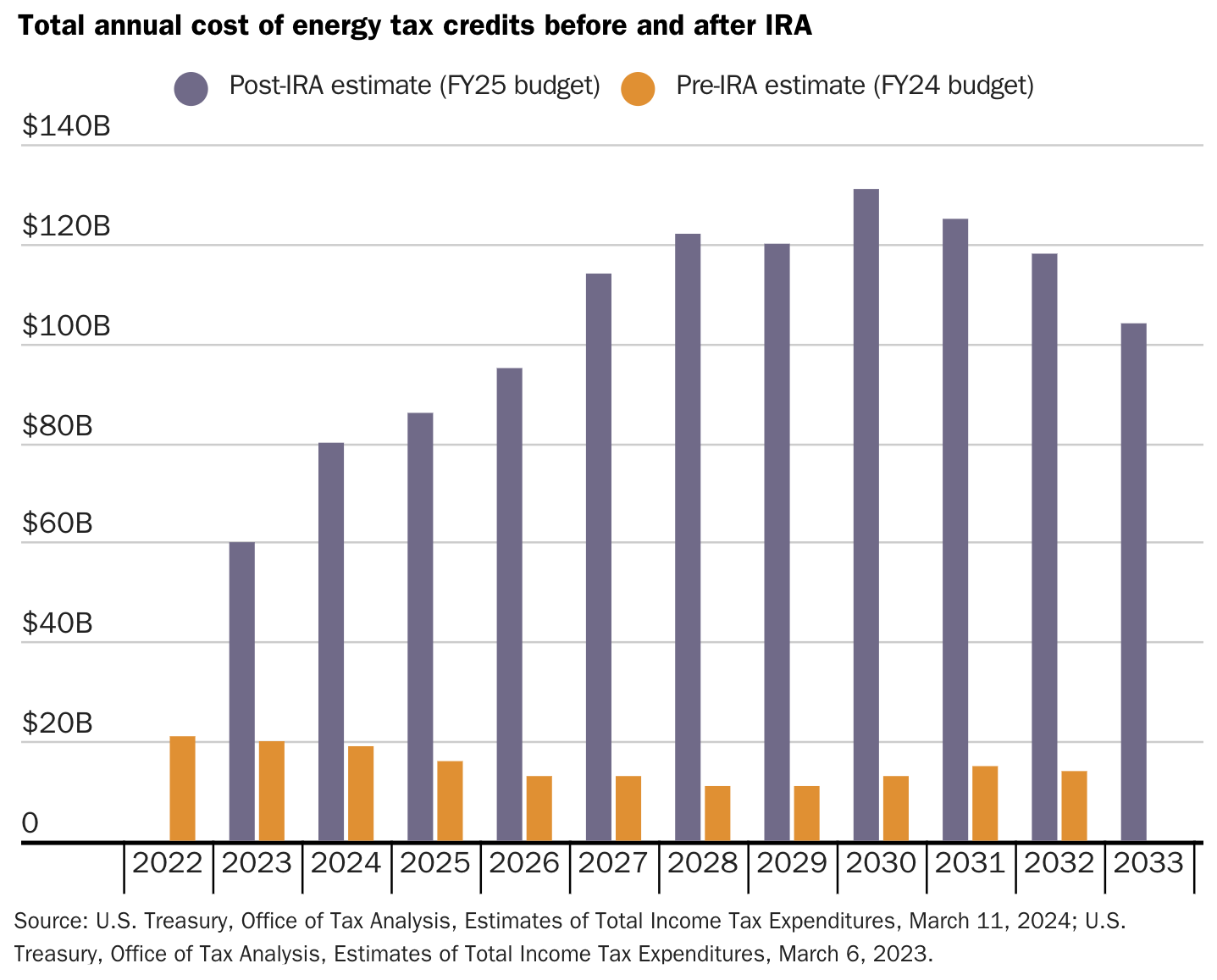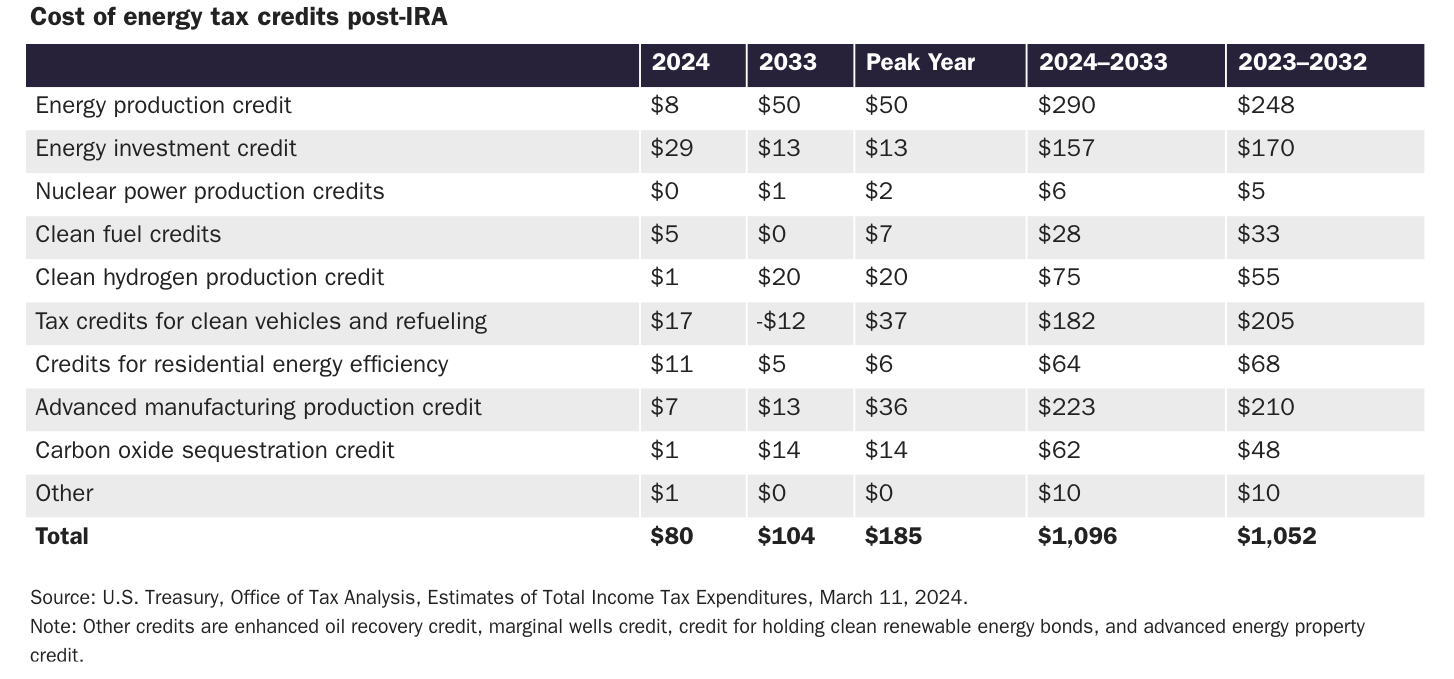A major flaw in the Inflation Reduction Act (IRA) is that there is effectively no cap on the tax subsidies that President Biden provides to his favorite “green” technologies. Despite more than four decades of subsidies for wind and solar technologies, the IRA continues to subsidize these technologies as if they were still emerging, which they are not. As Biden continues handing out taxpayer funds that promote these technologies, their intermittent production is causing instability to the electric grid and retirements of reliable coal, natural gas and nuclear generators as their reduced generation time no longer allows them to recover their costs. Further, with the radical push for wind and solar deployment, the United States is pouring money into China, who dominates the global market of solar panel exports and the critical minerals needed for wind and solar technology production.
Further, the taxpayer-funded tax incentives for Biden’s green technologies could increase even more as his Environmental Protection Agency (EPA) introduces regulations that push for even more wind and solar deployment and electric vehicle sales. The recently finalized tailpipe emissions rule and proposed power plant rule force greater adoption of these tax credit‐eligible technologies. And these regulations keep coming with the latest rule dealing with forced sales of electric delivery trucks and semis. The Biden Administration is breaking its promise that the bill would cost $369 billion by expanding its application in ways estimated by some to now exceed $1 trillion.
Massive IRA Subsidies for “Green” Technologies
Since IRA’s passage, the estimated cost of its energy tax credits has increased dramatically. At the time of passage, CBO and the Joint Committee on Taxation (JCT) estimated the IRA’s energy and climate spending and tax breaks would cost about $400 billion through Fiscal Year 2031 and would be more than fully offset by other parts of the law. Estimates now show that due to higher projected deployment, the cost of the IRA tax credits would be greater and could be three times larger than initially projected. An April 26, 2023 estimate by the Joint Committee on Taxation (JCT) indicated the cost of the IRA tax credits would be $515 billion from 2023 through 2033. The Committee for a Responsible Federal Budget estimates that energy-related provisions from the IRA will cost almost $870 billion through 2031, more than double the original $400 billion estimate or $1.1 trillion through 2033. An April 2023 Goldman Sachs report estimated that the IRA “will provide an estimated $1.2 trillion of incentives by 2032.”
The FY 2024 budget, which did not incorporate the IRA, projected energy tax credits would cost $145 billion between 2023 and 2032. The FY 2025 budget projects a cost of almost $1.1 trillion over the same period, implying the IRA energy tax credits will cost $907 billion over that time. The figure below shows the energy tax expenditure cost estimates by year from each budget.

The decreasing cost of the credits beyond 2030 is due to expiring provisions between 2027 and 2032 that Congress could extend and, in many cases, has historically done so. Other tax credits, such as the energy production tax credit, phases down based on a greenhouse gas emissions target which is unlikely to be hit in the next several decades, meaning the tax credits could be uncapped indefinitely.
At peak cost, the energy credits cumulatively reduce revenue by $185 billion a year, implying a ten‐year cost of more than $1.8 trillion. The table below summarizes the major energy tax credits and their costs at various points in time.

Conclusion
The value of the energy tax credits in the IRA is growing as Biden’s favorite “green” technologies are forced into the market by more and more regulations and the massive incentives provided by the IRA and other Biden legislation are encouraging companies to invest. For example, Warren Buffet has acknowledged that wind energy projects are not economically viable without government tax credits. He stated, “…on wind energy, we get a tax credit if we build a lot of wind farms. That’s the only reason to build them. They don’t make sense without the tax credit.” Despite Buffet making that statement a decade ago and wind production now capturing a 10-percent share of electricity generation, the federal subsidies persist, the U.S. grid becomes more unreliable, and electricity is more expensive for Americans, with residential rates increasing 28 percent since 2014. The worse absurdity is that the total cost of energy credits in the IRA is an unstable amount costing taxpayers trillions with effectively no cap, persisting for decades unless the legislation is repealed. It now looks as though the Inflation Reduction Act was sold to Congress under a false premise about its limited costs and those costs are now multiplying because of deliberate actions of the Biden Administration.
*This article was adapted from content originally published by the Institute for Energy Research.